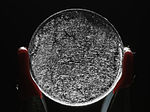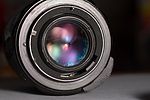Glass mushroom
Glass mushroom (also fungus from the Latin word for mushroom ) is the trivial name for the infestation of optical devices such as lenses with fungal threads ( mycelium ). By germination of fungal spores and renewed spore formation, the infestation can also spread beyond the respective fungal network. The glass surfaces of the devices are clouded by the fungal attack. Glass fungus can range from small, barely visible points to an irregularly spreading mesh (see illustration) to complete "blindness" of the optics.
The fungi that attack optical surfaces belong to the groups of egg fungi ( Peronosporomycetes) and sac fungi (Ascomycota, especially imperfect representatives). So "the glass mushroom" is not a specific type of mushroom.
The glass fungus does not feed on the glass itself, but on materials that were used in the manufacture of the optics and / or that adhere to it (leather, paint, wood, putty, adhesives, fibers). Lens surfaces can be attacked if organic material has deposited on them, such as vapors from plastics or grease. The fungus can also eat its way from the edge of the lens into a layer of cement between cemented lenses.
cleaning
The fungi can clean accessible lens surfaces under certain circumstances, but irreparable damage to the affected glass surfaces can also occur due to (often acidic ) metabolic products of the fungus.
Cleaning can be easy to very difficult, depending on whether and how the glass has been surface treated. For more expensive lenses in optics, it is sometimes advisable to ask the manufacturer and / or an independent optician.
In the case of glass without an anti-reflective coating , such as glass panes and drinking glasses, glass blindness (clouding of the glass due to periodically changing moisture and dryness) can possibly be remedied by cleaning the glass with a mixture of vinegar and salt. The glass must be completely rubbed with the mixture, then rinsed with water and then polished with a clean cloth.
Avoidance
Proper storage of optical devices can prevent fungal growth. The fungus thrives at temperatures of 10 ° C to 35 ° C and a relative humidity of 70% or more . Thus, a dry and warm storage is recommended, but the temperature should not exceed 50 ° C and the humidity not below 30%, as this could damage the device. The development of the fungus is also hindered by light.
- The relative humidity should be between 30% and 60%.
- An increased temperature of around 40 ° C is favorable
- Optical devices should be dried if necessary before they are packed or put in the cupboard.
- The surfaces of the front and rear lenses should be freed from dust and fibers so as not to provide a breeding ground for the fungus.
- Light and adequate ventilation should be provided.
Literature and Sources
- JS Turner, EI McLennan, JS Rogers, E. Matthaei: Tropic-Proofing of Optical Instruments by a Fungicide . In: Nature 158, 1946, pp. 469-473. ( online )
- Info from Zeiss about Glaspilz

